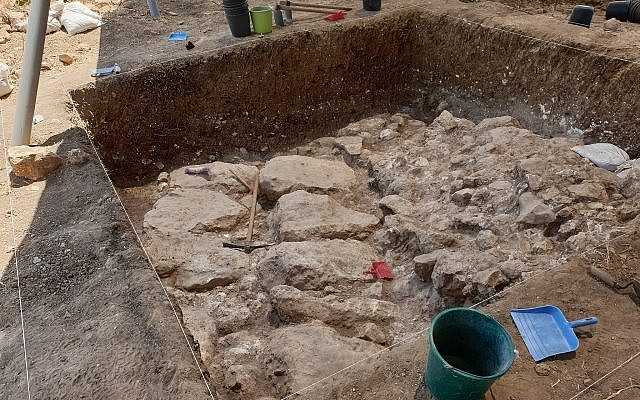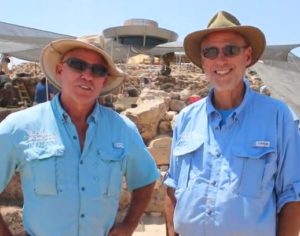 HEBRON — Large fortifications dating to the time of the biblical king David have been found below an archaeological dig site already thought to be Gath, the hometown of the giant Philistine Goliath.
HEBRON — Large fortifications dating to the time of the biblical king David have been found below an archaeological dig site already thought to be Gath, the hometown of the giant Philistine Goliath.
The walls, made of 3-6 foot stone blocks and large burnt bricks, were found at Tell es-Safi, a hill dig site not far from Hebron that has uncovered numerous finds from various time periods, including what appears to be that of the inhabitation of the Philistines.
Archeologists thought that discovered remains from the time of the destruction of Gath by Hazael, the king of Syria, as noted in 2 Kings 12:17 (“Then Hazael, king of Syria, went up and fought against Gath, and took it.”) would be the largest to be found at Tell es-Safi. However, this summer, it was decided to dig deeper, down at the lower city of Gath, to see what was there.
“I’ve been digging here for 23 years, and this place still manages to surprise me,” Aren Maeir, a professor of archaeology at Bar-Ilan University near Tel Aviv who leads the dig project, told Haaretz. “All along we had this older, giant city that was hiding just a meter under the city we were digging.”
“We got the feeling that perhaps this earlier phase [of Gath] is larger and dramatically more impressive than the city that was destroyed by Hazael,” he also outlined to The Times of Israel. “It’s a surprise, but on the other hand, it explains something. … The pieces fit together now much better.”
Maeir said that the finds below the current dig “show that the buildings and the fortifications were very large, built with extremely large stones,” as well as thick burnt brick that was rarely used before the Roman era. He also noted that the city itself would have been considered expansive compared to others in the area — approximately 123.5 acres.
The fortifications additionally date to the same era when David lived: the 11th Century B.C.
“For those scholars that accept that David was a historical figure — and I’m among them — the late 11th, early 10th century, the time of the earlier phase of the city of Gath, whose impressive remains were just found, is the time frame in which David existed,” Maeir stated.
However, he also remarked that since no giant skeletal remains have yet been found in Gath, perhaps the biblical record of Goliath being so large is a “mythical story” that was based on the size of the city.

The Pennsylvania-based Associates for Biblical Research (ABR) pushed back at the assertion, as it rather views the discovery as providing further observation into what is already stated in the Scriptures.
“For Christians, the archaeological discoveries of monumental structures, ‘Cyclopean’ stones, and extensive material culture, along with the results of DNA testing, all help to provide important historical details and insights into this formidable ancient enemy of Israel,” Director Scott Lanser told Christian News Network.
“While many reporting on these archaeological discoveries like to suggest that the evidence simply ‘hints’ at support for the ‘stories’ and ‘myths’ of the biblical text, we see the discoveries as adding important context and clarity to Bible’s plain intention to convey accurate, historical accounts regarding Israel and the Philistines,” he outlined.
“The Bible is clear that the issue was not just that extremely large stones were used in the construction of Philistine monumental architecture, but that a very large Philistine named Goliath was felled by a very small stone wielded by a rugged shepherd named David … a shepherd who would become Israel’s first king.”
Scott Stripling, ABR’s director of excavations, similarly contested Maeir’s suggestion that the account of Goliath of Gath is mythical.
“It is more likely that the Philistines who had arrived around 1177 from the Aegean region were physically larger than the Israelites and the largest of them were giants in the Israelites’ eyes,” he explained. “The LXX has Goliath at 6’9.””
1 Samuel 17:4 says that, in particular, Goliath’s “height was six cubits and a span.”
Gary Beyers, an archaeologist with ABR and professor of archaeology at Trinity Southwest University in New Mexico, expressed excitement over the find. He had been involved in an excavation at Philistine Ekron, and had visited Tell es-Safi prior to the discovery.
“This earlier occupation level at Gath will offer numerous insights on the Philistines early years on Canaan’s coast,” he remarked. “The Bible indicates they were a powerful entity in the region and now we’ll get an even better picture as to how powerful.”
“I look forward to all the possible biblical connections which will come from this level of the Philistine city — connections with ancient Israel, king David and maybe even Goliath!”
Become a Christian News Network Supporter...


